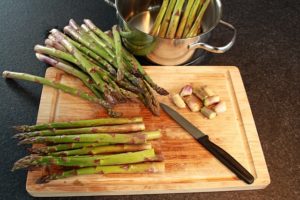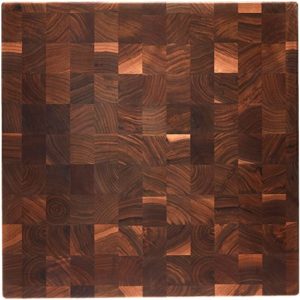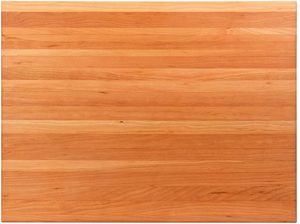Learn all you need in this Cutting Board Buying Guide
Are you looking to buy a cutting board for your kitchen, but you’re not sure where to start? A good cutting board can make your cooking life easier. There are several types to choose from, so which should you choose? HowToBuyA will give you the information you need to buy the right cutting board for you. We’ll also share some links to cutting boards that may suit your needs. Want to skip the How-To and get straight to the links? Click here for some HowToBuyA – Cutting Board Suggestions.
Affiliate notice: When you buy through our links, we may earn a commission.
Sections of this Cutting Board Buying Guide
- What to Look for When Buying a Cutting Board
- Wooden Cutting Boards
- Plastic Cutting Boards
- Rubber Cutting Boards
- Cutting Board Suggestions
- Wooden Cutting Board Suggestions
- Wooden Cutting Boards From the John Boos Company
- Wooden Cutting Boards From Sonder Los Angeles
- Plastic Cutting Board Suggestions
- Rubber Cutting Board Suggestions
- Cutting Board Care & Maintenance Products
- Wrap Up
What to Look for When Buying a Cutting Board
 A good cutting board can prolong the life of your knives and make your slicing, dicing, and chopping a breeze. Things to consider when choosing a cutting board include the size, weight, style, material, and price.
A good cutting board can prolong the life of your knives and make your slicing, dicing, and chopping a breeze. Things to consider when choosing a cutting board include the size, weight, style, material, and price.
Size
The larger the cutting board, the more space you have to prepare food. The board should sit firmly on your counter when you are using it. If it is too large, it might not fit. You also need to consider where you will store the cutting board. Measure your counter and storage space before you start shopping. Thicker boards will provide stability and durability but increase the weight of the board.
Weight
Cutting boards, especially wooden ones, can be very heavy. A heavier board is likely to be more durable, but some people might find moving around a heavy cutting board a nuisance and stop using it altogether. Heavier boards are often stationed on counters permanently, adding to the aesthetic of the kitchen. Lighter cutting boards might move around on you as you are cutting on them, requiring the use of a towel underneath to prevent slipping.
Style
 By far, the most common shape is rectangular, followed by circular. You can find other shapes, however, a cheese board shaped like a wine glass, for instance. You can also choose from boards with or without handles. Some cutting boards have a juice groove to catch liquids that are flowing from your meats, vegetables, or fruits. Regarding the above-mentioned slipping, some boards have rubber “feet” that you can insert into the bottom to prevent them from moving during use. Finally, many boards are reversible, meaning you can use both sides of the board. These choices are all personal preferences; there is no right or wrong.
By far, the most common shape is rectangular, followed by circular. You can find other shapes, however, a cheese board shaped like a wine glass, for instance. You can also choose from boards with or without handles. Some cutting boards have a juice groove to catch liquids that are flowing from your meats, vegetables, or fruits. Regarding the above-mentioned slipping, some boards have rubber “feet” that you can insert into the bottom to prevent them from moving during use. Finally, many boards are reversible, meaning you can use both sides of the board. These choices are all personal preferences; there is no right or wrong.
Material
Probably the biggest decision you will need to make is what material you want for your cutting board. The three main choices are wood, plastic, and rubber. Each has advantages and disadvantages when considering factors such as price, durability, weight, resistance to bacteria, cleaning method, and maintenance.
Let’s take a closer look at each material.
Wooden Cutting Boards
Sanitary
Wood tends to be the preferred material for most cooks because of its durability and resistance to bacteria. When a knife cuts on a board, it can slice into the board, leaving cuts and gashes behind. With plastic, those cuts and gashes can harbor bacteria, which can be difficult to clean. Wood possesses a natural resistance to these bacteria, making it a safer choice for preventing foodborne illness. Wood can also be resurfaced with sandpaper to remove cut marks.
Large, heavy, & durable
Wooden cutting boards are often available in sizes larger than what you may find with plastic boards. Wooden cutting boards are usually heavier than plastic or rubber boards; thicker wooden boards can be extremely heavy and are often stationed permanently on a kitchen counter. A wooden cutting board, if properly cared for, is extremely durable and can last a lifetime.
High maintenance
One disadvantage of wooden cutting boards is the time required for cleaning and maintenance. Wooden cutting boards should not be placed in the dishwasher and must be washed by hand. Never soak a wooden board in water. To keep the board in good shape, it is also recommended to apply regularly (once a month or more frequently) an appropriate oil to the surface of the board, followed by a cream or wax to help seal the board from moisture. Wooden cutting boards that are not properly maintained can crack, split, or warp, leaving you with an expensive piece of firewood.
See our wooden cutting board suggestions here.
Types of wood used
Several types of wood are commonly found in cutting boards: cherry, walnut, teak, maple, hinoki (a Japanese cypress), and bamboo, among others. These woods vary in their hardness. The harder the wood, the more damage it will do to your knife, which means you will need to sharpen it more frequently. The softer the wood, the easier it will be for the board to get cuts or scratches. Hinoki is a soft wood that should be avoided unless you have specific types of Japanese knives. Bamboo (which is technically a grass) is popular for its looks but is too hard on knives and should also be avoided. Moving from softer to harder, cherry, walnut, teak, and maple are all in the middle range of hardness and thus very suitable woods for cutting boards.

Wood grain
The way in which wood is cut and glued together determines how the fibers in the wood, the grain, flow within the cutting board, which affects how the board reacts to a knife. This construction of the board can make a big difference in quality and price. By far, the most expensive and best quality boards are termed “end grain.” An end-grain board is less likely to scratch or scar. It is also more forgiving on your knife’s edge, helping keep it sharp longer. End-grain boards can be distinguished by their stylish checkerboard pattern. The next-best boards are “edge grain,” which are much less expensive but still good quality. If the information for a cutting board mentions neither “end grain” nor “edge grain,” then it may be “face grain,” which can have beautiful grain patterns but is much easier to scratch and less durable as well.

Stylish but expensive
Wooden cutting boards can also be quite expensive. The best end grain boards range into the hundreds of dollars. If you cook frequently, though, you can consider this an investment since a well-cared-for wooden cutting board should last a lifetime. Finally, wooden cutting boards look great and can be a stylish addition to any kitchen.
Plastic Cutting Boards
Inexpensive & lightweight
Many people prefer plastic cutting boards because of their low cost compared to wooden boards. They are much lighter than wooden cutting boards and can be easier to store when not in use. A common complaint with plastic cutting boards is their tendency to slip or move while cutting, which can be dangerous. Look for boards that are non-slip or have rubber feet attached.
Low maintenance
Unlike wooden cutting boards, plastic cutting boards can be washed in a dishwasher, which makes their cleanup a breeze. As mentioned, plastic cutting boards will develop cuts, scratches, and scarring over time, which can lead to bacteria build-up that can be difficult to remove with just soap and water. The plastic surface, along with the cuts and scratches, can become stained from certain foods. Washing with a bleach solution is one way to keep plastic boards free from bacteria and remove stains.
See our plastic cutting board suggestions here.
Food safe
Plastic cutting boards made from HDPE plastic are free from BPA and considered food-safe by the FDA. The USDA recommends using a separate cutting board for raw food to avoid cross-contamination. Because they are relatively cheap, many cooks will have several plastic cutting boards on hand and use different boards for different types of food. Plastic cutting boards often come in sets of conveniently color-coded boards (pink for meat, green for vegetables, etc.).
Economical
Although not as stylish as wooden boards, plastic cutting boards offer a low-cost, low-effort alternative. You can find a set of four boards for about $20. Many people will simply discard their plastic cutting boards and buy new ones once they become overly scratched up or worn out.
Rubber Cutting Boards
The middle ground
A final option, somewhere between plastic and wood, is rubber cutting boards. According to the manufacturer, Notrax, their rubber cutting boards are made from a high-density rubber compound that won’t crack, splinter, swell, or absorb liquids or odors and last far longer than cutting boards made from wood or plastic. Because they are rubber, they will not slip or move while cutting. They are resistant to bacterial growth, NSF certified, non-toxic, and comply with FDA guidelines. They are easier on knives than plastic and can be resurfaced with sandpaper, like wood.
See our rubber cutting board suggestions here.
Maintenance
Also, like wood, these rubber boards should not be placed in a dishwasher and must be washed by hand with soap. They do not, however, need to be oiled and waxed. They can be expensive, but not as expensive as your top-line end-grain cutting boards. They lack the style and beauty of wooden cutting boards, but considering their longevity and durability, they are a great alternative to plastic boards.
HowToBuyA – Cutting Board Suggestions
Now that you have a good idea of what to look for in a cutting board, here are some cutting board suggestions sorted by board material. If you are interested in purchasing a wooden cutting board, be sure to take a look at the Care & Maintenance Products as well.
Affiliate notice: When you buy through our links, we may earn a commission.
Wooden Cutting Board Suggestions
There are dozens of sellers on Amazon selling wooden cutting boards, but HowToBuyA~ recommends two manufactures for their quality and workmanship, John Boos Company and Sonder Los Angeles.
John Boos Company: The most trusted brand of wooden cutting boards belongs to the John Boos Company, out of Illinois, and their extensive variety of Boos Blocks. Their cutting boards are well made and stylish. They can be very expensive, but their customers insist that they are worth it. Browse through their boards by type of wood here.
Sonder Los Angeles: A less expensive alternative is the cutting boards from Sonder Los Angeles, a small company from California with a good reputation for quality and customer service. While they don’t have as many product offerings, their cutting boards receive great reviews. Most of their cutting boards sell for under $100. See their product line-up here.
Made in the U.S.A., the cutting boards from both of these companies offer excellent craftsmanship. If you follow their care and maintenance guidelines, including regular oiling and sealing, a wooden cutting board from either of these companies should last a very long time. At the time of writing this article, both companies offer a one-year warranty. However, the John Boos Company requires the customer to pay return shipping, whereas Sonder Los Angeles will cover return shipping within the warranty. Please see each company’s respective warranty details for more information as this could change at any time.
Wooden cutting boards from the John Boos Company.
Wooden cutting boards from Sonder Los Angeles.
Plastic Cutting Board Suggestions
Rubber Cutting Board Suggestions
Rubber cutting boards from the Notrax company:
Notrax – Sani-Tuff Premium Rubber Cutting Board, Professional Grade
Notrax – Sani-Tuff Premium Rubber Cutting Board, Professional Grade – Round
Cutting Board Care & Maintenance Products
When it comes to oiling your wooden cutting board, there are many popular products available, some of which we will list below. However, all you really need is a quality food-grade mineral oil. We have two suggestions here and here. Mineral oil is an amazing product with many uses beyond oiling your cutting board. Use it on any wood to moisturize and protect, including all of your wooden kitchen utensils and knife handles. It can be used to oil moving parts on kitchen machines and electric shavers. It can be used to clean and protect metal surfaces, such as of your knives, appliances, or the kitchen sink. Mineral oil can be used as a non-fragrant replacement for baby oil. There are probably more uses; the point being, instead of buying expensive specialty oils, you might as well get a gallon of food-grade mineral oil that does exactly the same thing and can be used in other ways. Just make sure that it is “food grade” as non-food-grade mineral oil may contain impurities that you do not want in or on your cutting board.
How to oil your board. Use a cloth, silicone brush, or unused paintbrush to spread the oil completely over the board. The oil will soak up into the board. Add more oil if a particular area seems “thirsty.” Leave the board with a film of oil overnight, either standing upright in a dishrack or lying on a wire rack over a towel. Repeat this process until the board no longer soaks up the oil. Some larger, thicker boards may be very thirsty and need several rounds of oil. Wipe up any remaining oil and then apply board wax/cream to the entire surface of the board. This process should be repeated monthly, though the amount of oil needed to re-oil the board should be much less.
Check out these care and maintenance products for your cutting boards:
Wrap Up
We hope you have learned enough about cutting boards to find the right cutting board for you and your kitchen. Let us know what kind of cutting board you end up buying and why in the comments below.











































